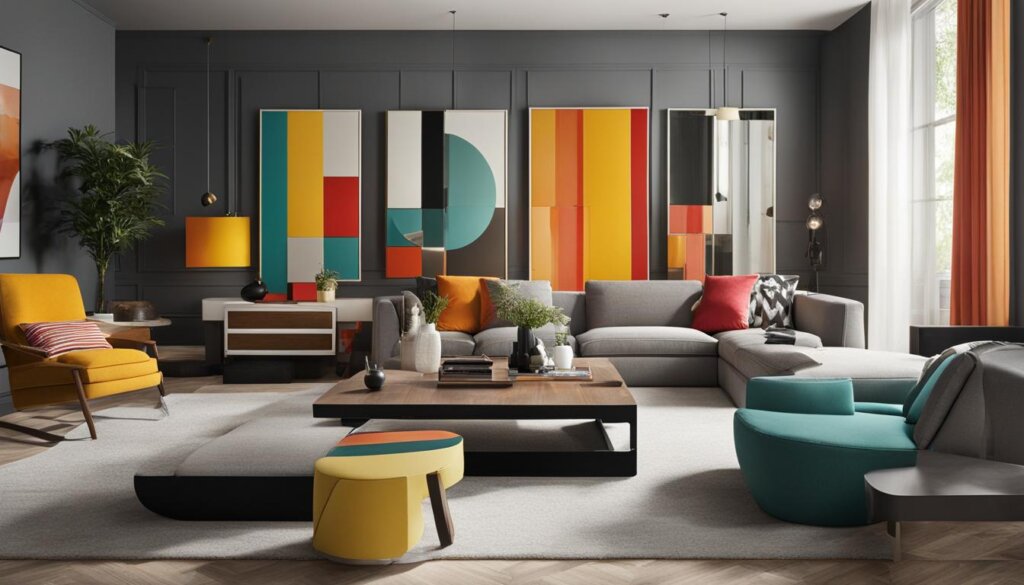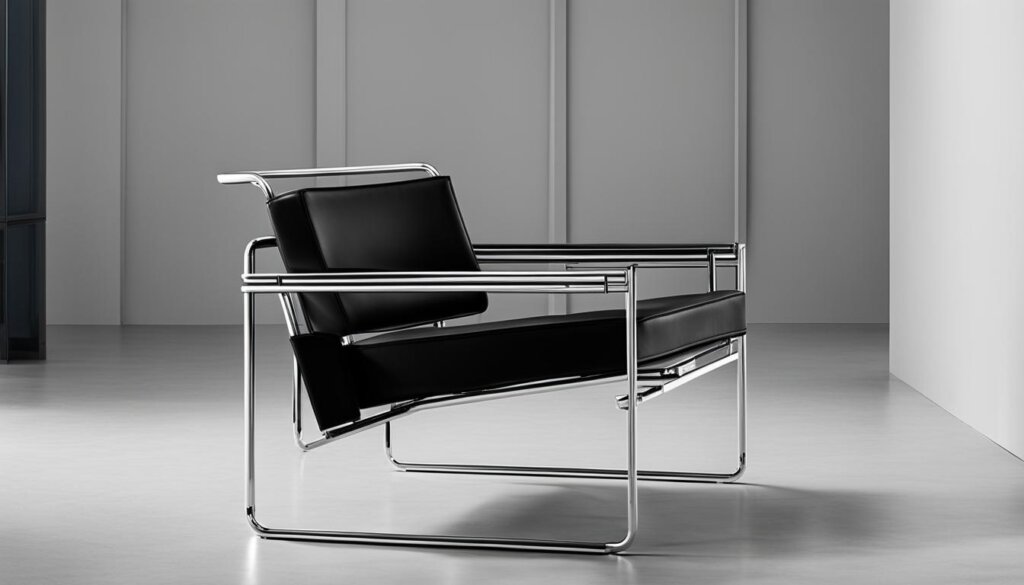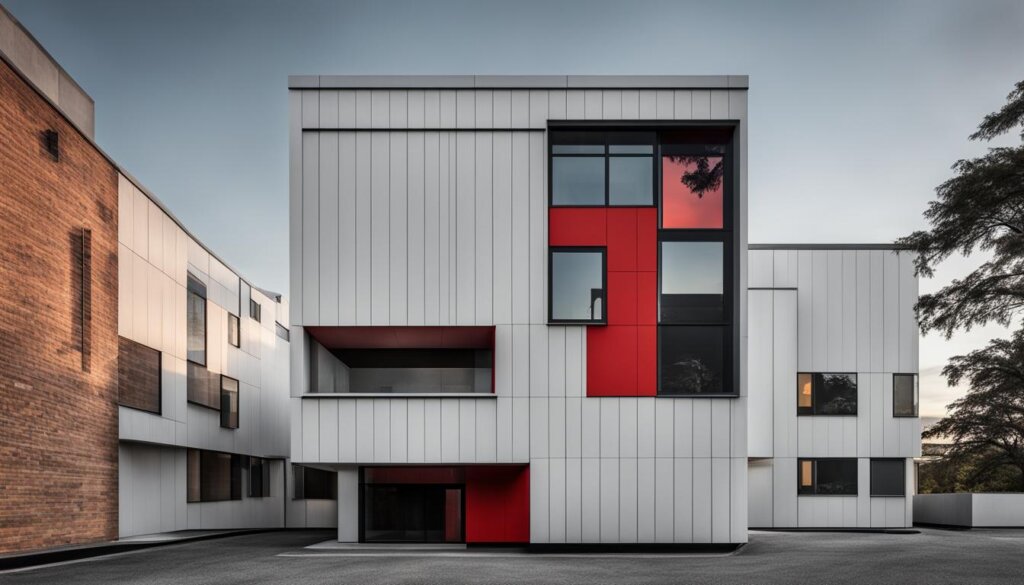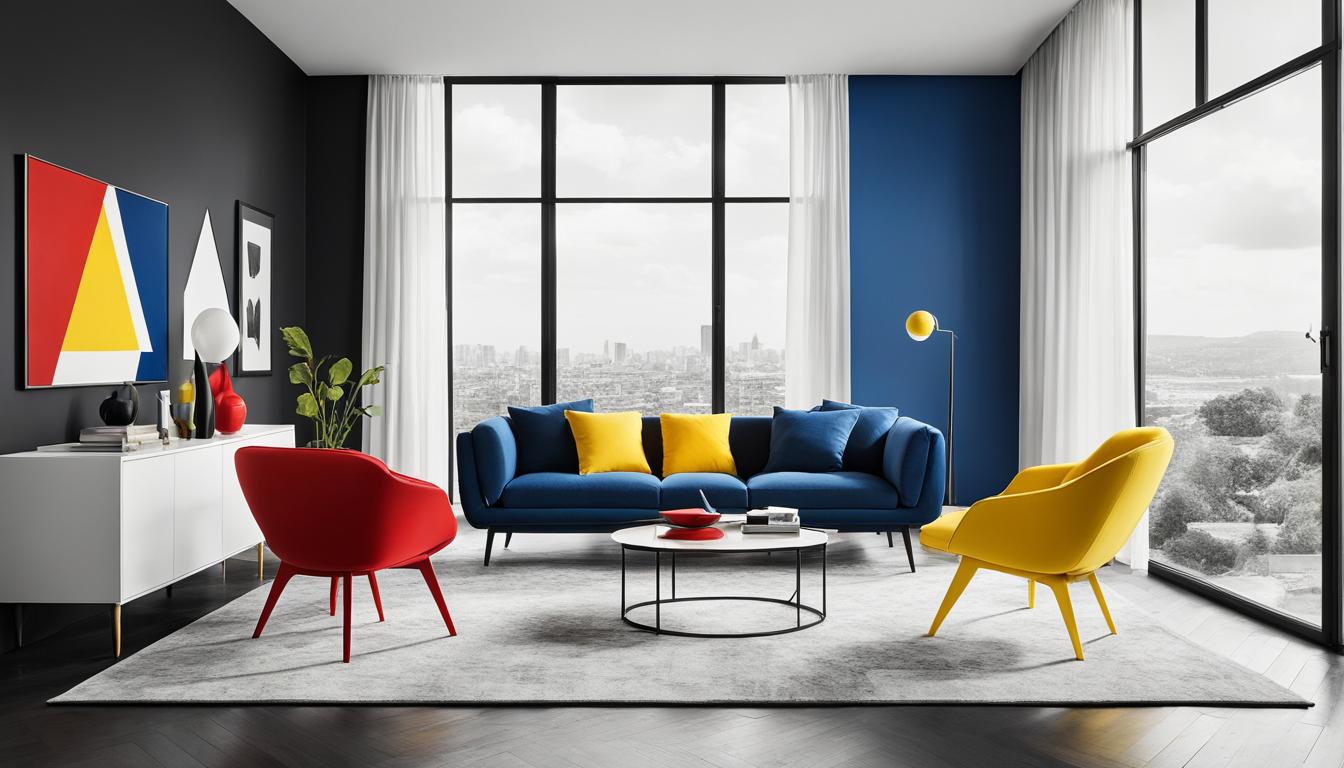Welcome to our modern design guide where we delve into the world of Bauhaus decor. If you’re a fan of sleek and minimalist interiors, Bauhaus style interior design might be the perfect fit for you. Originating from Germany’s Bauhaus School of Art and Design, this design movement has shaped modern interior design with its emphasis on clean lines, geometric forms, and functional aesthetics.
When it comes to Bauhaus furniture and decor, think simplicity and practicality. This style embraces minimalism, utilizing industrial materials and primary colors to create a contemporary and timeless look. Whether you’re a fan of mid-century modern, Scandinavian, or industrial design, Bauhaus can seamlessly integrate into any space.
In this guide, we’ll take you through a brief history of the Bauhaus movement, discuss its key characteristics, show you how to incorporate Bauhaus design principles into your home, introduce you to iconic Bauhaus designs, and explore the enduring influence of Bauhaus in contemporary architecture and design. So let’s dive into the world of Bauhaus and unleash your creativity!
A Brief History of the Bauhaus
The Bauhaus School of Art and Design, founded by Walter Gropius in 1919, marks a significant milestone in the history of modern art and design. Emerging in the early 20th century, the Bauhaus movement revolutionized the way we think about architecture, furniture, and everyday objects.
Walter Gropius established the Bauhaus School with a vision to unite various artistic disciplines and develop a new approach to design that embraced modernism. The school attracted acclaimed artists and designers such as Wassily Kandinsky, Paul Klee, and Ludwig Mies van der Rohe, who pushed the boundaries of creativity and incorporated principles of functionalism and industrial materials into their work.
Despite facing challenges and ultimately closure under pressure from the Nazis in 1933, the impact of the Bauhaus extended far beyond its physical existence. The movement spread its influence to countries such as Russia, Switzerland, Israel, and the United States, inspiring generations of artists and designers worldwide.
Today, the legacy of the Bauhaus can be seen and appreciated in various museums dedicated to preserving its history and showcasing its innovative designs. These museums not only pay homage to the Bauhaus School of Art and Design but also serve as educational hubs for exploring the principles of modern art and design.

As we delve deeper into the world of Bauhaus, we will explore the characteristics of this influential design movement and discover how to incorporate its principles into our own homes.
Characteristics of Bauhaus Interior Design
Bauhaus interior design is an iconic style that showcases the principles of “form follows function.” We prioritize practicality and functionality while creating a visually appealing space. Let’s explore the key characteristics that define Bauhaus interior design:
- Geometric Forms: Bauhaus design embraces geometric shapes, such as squares, triangles, and circles, adding artistic elements to furniture and decor. These shapes create a sense of balance and harmony within the space.
- Simple Design: Bauhaus design focuses on simplicity and minimalism. Clean lines and simple shapes are prominent features that eliminate unnecessary ornamentation, giving a streamlined and uncluttered look.
- Industrial Materials: The use of industrial materials, such as wood, metal, concrete, and glass, is prevalent in Bauhaus spaces. These materials reflect the practical and durable nature of the design.
- Minimal Ornamentation: Bauhaus interior design relies on minimal ornamentation. It embraces a minimalist aesthetic, allowing the practical and functional aspects of the design to take center stage.
- Primary Colors: Primary colors, including red, blue, and yellow, are commonly used in Bauhaus design to add pops of color and create visual interest. White and grey serve as the base color palette, providing a neutral backdrop for vibrant accents.

Incorporating Bauhaus Design Principles into Your Home
To create a modern and functional living space inspired by Bauhaus design, it’s important to consider key principles such as simplicity, practicality, and experimentation. By following these guidelines, you can transform your home into a stylish haven that reflects the timeless aesthetics of the Bauhaus movement.
Simple Furniture Designs
When selecting furniture for your Bauhaus-inspired home, opt for simple designs that prioritize functionality and minimalism. Look for clean lines and geometric shapes that embody the Bauhaus ethos. Pieces with streamlined forms and understated details will contribute to the overall sleek and minimalist look.
Practical Materials
Choose furniture and decor made from practical materials that are durable and easy to maintain. Consider utilizing wood, glass, metal, or concrete to capture the industrial feel characteristic of Bauhaus design. These materials not only emphasize the minimalistic aesthetic but also ensure longevity and functionality in your home.
Minimize Clutter
To achieve the uncluttered and minimalist look synonymous with Bauhaus design, it’s essential to minimize unnecessary items and declutter your space. Keep surfaces clean and free from excessive ornaments or decorations. Embrace open spaces and allow furniture and key design elements to stand out, promoting a sense of tranquility and order.
Pops of Color
Add vibrant pops of color to your decor to infuse your home with modern appeal and showcase your unique personality. Bauhaus design often incorporates primary colors such as red, blue, and yellow to create bold visual statements. Consider using colorful accent pieces, artwork, or textiles to introduce these hues and energize your space.
Emphasize Lighting
Lighting plays a crucial role in Bauhaus-inspired interiors, emphasizing the interplay of light and geometric shapes. To enhance the atmosphere and create an energetic and bright ambiance, incorporate both natural and artificial lighting. Position floor lamps strategically to highlight key design elements and ensure well-lit areas throughout your home.

Experimentation
Embrace the spirit of experimentation to truly embrace Bauhaus design principles. Challenge traditional design norms and explore new ideas to create a comfortable and enjoyable living environment that reflects your personal style. Don’t be afraid to mix and match elements from different design styles, allowing yourself the freedom to create a space that is uniquely yours.
Bauhaus Design Icons
The Bauhaus has produced several iconic designs that have stood the test of time. Let’s explore a few of these iconic pieces that showcase the essence of Bauhaus design.
The Wassily Chair

Designed by Marcel Breuer, the Wassily Chair is one of the most famous pieces of Bauhaus furniture. Its innovative use of bent steel tubing and minimalist design exemplifies the Bauhaus style. The iconic chair is not only a functional seating option but also a work of art that has become a symbol of modern design.
The Barcelona Chair
Created by Ludwig Mies van der Rohe and Lilly Reich, the Barcelona Chair is another quintessential Bauhaus design. This luxurious chair features sleek lines and a minimalist aesthetic, showcasing the elegance and simplicity that defines Bauhaus style. The Barcelona Chair has remained a timeless masterpiece loved by design enthusiasts around the world.
The Tea Infuser
While the Wassily Chair and the Barcelona Chair may be more well-known, the Tea Infuser designed by Marianne Brandt is a small but significant Bauhaus design. This tea strainer demonstrates the Bauhaus approach to blending geometric shapes and functional aesthetics. Its simple yet modern design reflects the Bauhaus philosophy of combining form and function in everyday objects.
These iconic Bauhaus designs continue to inspire and influence the world of art and design. Their timeless appeal and innovative use of materials and shapes make them true icons of modern design.
The Enduring Influence of Bauhaus Design
Bauhaus design continues to have an enduring relevance in the world of art and design. Its emphasis on functionality, simplicity, and minimalism has shaped contemporary architecture and design. The principles of Bauhaus design have influenced various design styles, making them timeless and relevant in the modern design world.
Bauhaus designers were pioneers in exploring new material applications, which are still widely used today. One prominent example is the use of steel tubing in furniture design, which offers a combination of strength and sleek aesthetics. These material applications have become a hallmark of contemporary architecture, providing designers with endless possibilities to create innovative and visually striking spaces.
The philosophy of minimalism embraced by Bauhaus design continues to inspire designers and architects alike. By stripping away unnecessary ornamentation, Bauhaus designers celebrated the beauty of simplicity. This philosophy is now widely embraced in modern design, from architecture to interior decor. The clean lines and minimalistic aesthetic of Bauhaus design create spaces that are visually pleasing, functional, and timeless.
Embracing Craftsmanship and Material
Bauhaus design not only prioritizes minimalism but also celebrates craftsmanship and material. This emphasis on quality and attention to detail in relation to material choice has become ingrained in contemporary design. The Bauhaus movement recognized the importance of understanding the properties of materials and using them in innovative ways to achieve both form and function. Today, this approach is evident in the thoughtful material choices and the careful consideration of craftsmanship in contemporary design.
Examples of Bauhaus Influence in Contemporary Design
- Contemporary architecture often incorporates Bauhaus design principles, with its clean lines, geometric shapes, and emphasis on functionality. Architects such as Zaha Hadid, Renzo Piano, and Frank Gehry have all drawn inspiration from Bauhaus design.
- Bauhaus-inspired furniture, with its minimalist aesthetic and unique material applications, is incredibly popular in contemporary interiors. Designers like Charles and Ray Eames, Ludwig Mies van der Rohe, and Marcel Breuer have left a lasting impact on furniture design.
- The concept of minimalism, central to Bauhaus design, has influenced various aspects of contemporary design, from fashion to graphic design. Brands like Apple and Muji have adopted the clean and simple aesthetic synonymous with Bauhaus.

Embrace Bauhaus in Your Home
Are you ready to bring the timeless elegance of Bauhaus design into your own living space? With a mix of styles and a touch of personalization, you can create a home that reflects your unique taste and style. Start by incorporating the principles of Bauhaus design while combining them with other design elements to create a space that is truly your own.
One way to infuse your home with the spirit of Bauhaus is by selecting furniture that is both simple and functional. Coaster Furniture offers a wide range of options that perfectly blend modern aesthetics with practicality, allowing you to create a space that is stylish and functional.
Don’t be afraid to personalize your space by adding your own unique touches. Mix and match different design elements to create a truly eclectic and one-of-a-kind look. Experiment with colors, patterns, and textures to create a space that reflects your personal aesthetic and showcases your individuality.
When it comes to furnishing your home, Coaster Furniture offers an array of choices that cater to various design styles. Whether you prefer minimalist pieces or bold and contemporary designs, Coaster Furniture has something for everyone. Use their store locator to find local retailers near you for convenient delivery or pickup options.

